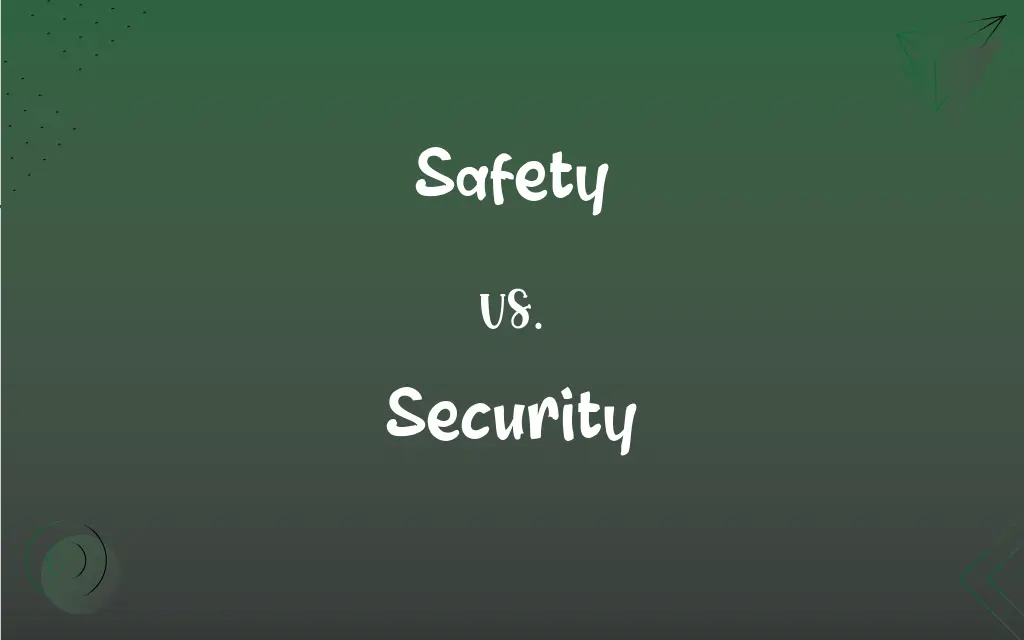Safety vs. Security: What's the Difference?
Edited by Aimie Carlson || By Harlon Moss || Published on November 27, 2023
Safety is protection from accidents and harm, while security focuses on protection from deliberate threats like crime or attacks.

Key Differences
Safety and security are two concepts that are often used interchangeably, but they have distinct meanings and applications. Safety generally refers to the condition of being protected from or unlikely to cause danger, risk, or injury. It is primarily concerned with accidental harm and the measures taken to prevent such incidents. On the other hand, security focuses on the protection against deliberate threats, such as theft, espionage, or violence. This involves implementing systems and procedures to guard against intentional harm or attacks.
In the context of workplace environments, safety and security play critical roles but address different aspects. Workplace safety involves creating an environment where employees are protected from physical harm caused by accidents or unintentional actions, such as machinery malfunctions or hazardous material spills. Workplace security, however, concentrates on protecting employees and company assets from intentional acts like theft, vandalism, or physical assault. Both aspects require distinct policies and training to ensure a comprehensive protective environment.
In terms of personal well-being, safety and security again have unique connotations. Personal safety involves taking precautions to prevent accidents or harm in daily life, such as wearing seat belts or following safety guidelines during recreational activities. Personal security, in contrast, is about safeguarding oneself from deliberate harm by others, which could include taking self-defense classes or ensuring home security against intruders. Both elements are essential for an individual’s overall well-being and peace of mind.
Technology plays a pivotal role in enhancing both safety and security, though in different ways. Technological advancements in safety include the development of automated safety systems in vehicles, fire suppression systems in buildings, and medical devices to monitor health. In the realm of security, technology has led to sophisticated surveillance systems, cybersecurity measures to protect data, and advanced access control systems. Both domains continuously evolve with technological innovations, offering improved ways to protect against their respective risks.
In a broader societal context, the concepts of safety and security are integral to the functioning and stability of communities. Public safety measures, such as law enforcement, emergency services, and health regulations, aim to protect citizens from accidents and health hazards. Public security, however, focuses on protecting communities from crime, terrorism, and other deliberate acts of violence. Effective governance and policy-making require a balanced focus on both safety and security to ensure a harmonious and protected society.
ADVERTISEMENT
Comparison Chart
Primary Concern
Preventing accidents and harm
Protection from deliberate threats
Typical Measures
Safety protocols, hazard mitigation
Surveillance, access control, encryption
Focus in Organizations
Workplace safety, product safety
Information security, asset protection
Regulatory Framework
Health and safety standards
Law enforcement, privacy laws
Cultural Perception
Seen as ensuring well-being and hazard-free environment
Associated with protection from external threats
ADVERTISEMENT
Safety and Security Definitions
Safety
A state where risks and hazards are controlled or eliminated.
Safety regulations in factories reduce the risk of injuries.
Security
Measures taken to guard against crime or attack.
Airport security checks are vital for passenger safety.
Safety
Measures taken to protect people from accidents or harm.
Fire drills are essential safety practices in schools.
Security
Protection of a state, organization, or individuals against external threats.
Cybersecurity measures protect data from hackers.
Safety
The condition of being protected from or unlikely to cause danger, risk, or injury.
Wearing helmets increases safety for cyclists.
Security
The assurance of safety and stability in a societal context.
National security is a priority for the government.
Safety
The assurance that an environment is free from danger.
The new safety measures made the construction site much safer.
Security
The state of being free from danger or threat.
The security system in the building deters potential burglars.
Safety
Pertaining to the protection of health and well-being.
Food safety standards ensure the healthiness of what we eat.
Security
Safeguarding information, assets, and infrastructure.
Enhancing security protocols is key to preventing data breaches.
Safety
The condition of being safe; freedom from danger, risk, or injury.
Security
Freedom from risk or danger; safety.
Security
Freedom from doubt, anxiety, or fear; confidence.
Security
A group or department of private guards
Call building security if a visitor acts suspicious.
FAQs
How does security differ from safety?
Security focuses on protection from intentional, external threats.
What are common safety measures in the workplace?
Safety training, protective equipment, and hazard signs.
What is the purpose of security clearance?
To ensure individuals have authorized access to sensitive information.
Can safety and security overlap?
Yes, especially in areas like public safety where both are crucial.
What is a safety protocol?
A set of procedures designed to prevent accidents and injuries.
What role does security play in information technology?
It protects data and systems from unauthorized access or cyber threats.
How important is security in financial transactions?
Extremely, to protect against fraud and unauthorized access.
What is the main goal of safety?
To prevent accidents and ensure a hazard-free environment.
Are safety standards universal?
They vary by region but often follow international guidelines.
Can security measures infringe on privacy?
Potentially, hence the need for balance and regulatory compliance.
How do security cameras contribute to safety?
They deter criminal activities and monitor for threats.
What is personal safety?
Measures an individual takes to protect themselves from harm.
How does safety affect consumer products?
It ensures products are free from hazards and safe to use.
Can security systems be hacked?
Yes, which is why continuous updates and monitoring are essential.
Is public safety a responsibility of the government?
Yes, it's a key aspect of governance and public service.
How does cybersecurity protect businesses?
By safeguarding against data breaches and cyber attacks.
What are the legal implications of safety regulations?
Non-compliance can lead to fines, penalties, or legal action.
What is an example of a safety hazard?
Slippery floors or exposed electrical wiring.
Why are safety drills important in schools?
To prepare students and staff for emergency situations.
What is the difference in training for safety vs. security?
Safety training focuses on accident prevention, while security training on threat response.
About Author
Written by
Harlon MossHarlon is a seasoned quality moderator and accomplished content writer for Difference Wiki. An alumnus of the prestigious University of California, he earned his degree in Computer Science. Leveraging his academic background, Harlon brings a meticulous and informed perspective to his work, ensuring content accuracy and excellence.
Edited by
Aimie CarlsonAimie Carlson, holding a master's degree in English literature, is a fervent English language enthusiast. She lends her writing talents to Difference Wiki, a prominent website that specializes in comparisons, offering readers insightful analyses that both captivate and inform.
































































